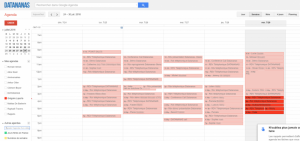If there is one thing that is important to us here at Datananas, it’s helping sales representatives avoid wasting their time on time-consuming tasks.
Do you want to know how to fill your sales representatives’ calendars from Monday through Friday with qualified meetings? Follow the guide!
Here is an example of a typical week for one of our Account Executives:
Note that this shows qualified meetings with prospects who correspond to our ICP, and not meetings with cold leads.
Here are a few techniques for optimizing your sales representatives’ useful time:
Don’t schedule physical meetings
When you go out, you have to add waiting time, time to get there, etc., to the meeting time.
Why would you go out, when you can have a phone call or use software or screen sharing for a remote demonstration?
Of course, based on the product you are selling and your average bundle, a physical meeting might be worth it for your organization.
Sales representatives team
In a future article we will explain why your sales representatives should be 100% focused on sales, and that means specializing your sales team.
Your sales representatives shouldn’t spend time creating prospect lists or qualifying prospects. Give this task to a more junior Sales Development Representative, who should provide your Account Executive with sales meetings with qualified prospects.
Set up a Sales 2.0 process
If this type of sales process is adapted to your business, set up a Sales 2.0 process to save time.
By using software like Datananas in a Sales 2.0 process (and not just for simple marketing emails), you will save your SDRs’ precious time.
If they are spending less time creating prospect lists and generating leads, they can manage a higher volume of prospects, and mathematically, generate more meetings for your Account Executives.
Be firm about your time management
Do not hesitate to be firm about time management.
Has a prospect requested a physical meeting, or wants to drop by your office? Refuse!
Have you realized after a few minutes of conversation that your prospect is not at all qualified? Tell him so, and cut the conversation short instead of spending thirty minutes on a demonstration to someone who will not buy anything anyway, or who will not be satisfied with his purchase.
Knowing how to refuse meetings or demonstrations is displaying a certain type of professionalism: you cannot waste any time, and you do not want to waste your prospects’ time either.
By combining these tips, you can fill up your sales representatives’ agendas and optimize their time!
Of course, this advice is only useful if you are dealing with large volumes – that is, with a very wide audience and a very low ACV (average deal).
